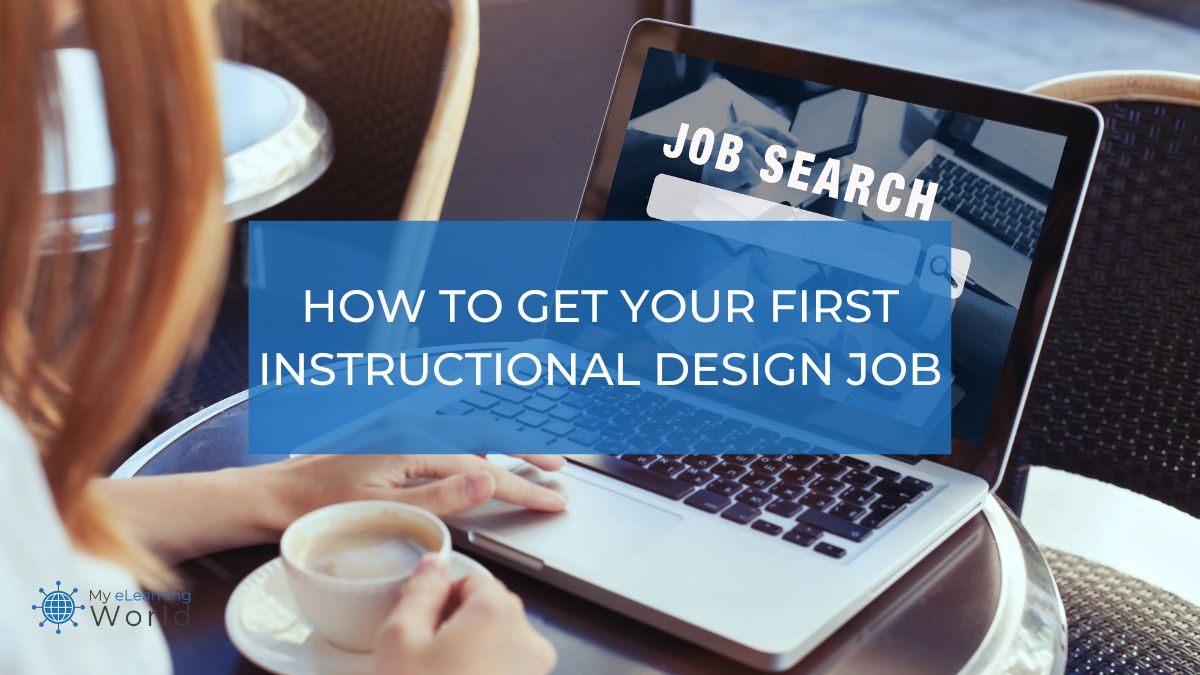If you’re trying to land your first job as an instructional designer, I have some good news for you — your skills are in high demand. According to Inside Higher Ed, instructional designers are some of the most sought-after professionals in higher education right now. Not only that, the Bureau of Labor Statistics projects a faster-than-average growth in the instructional design job market over the next decade.
As someone who’s been working in the industry for years now, I know what it takes to land a job with a competitive salary in this field. In this article, I’ll share some practical steps and strategies to help you as you embark down the instructional design career path and try to get your first job.
Watch the Video
Check out our latest video below where we offer tips and secrets to get your first ID job!
7 Tips for Getting Your First Instructional Design Job
1. Get the Right Degree, Training, and Certifications
 Emeritus Professional Instructional Design Certificate | Online Certificate Course
Emeritus Professional Instructional Design Certificate | Online Certificate Course
Gain firsthand expertise in instructional design principles and methodologies through this unique Professional Certificate program. Create impactful learning solutions and improve people's ability to learn.
If you’re gearing up to land your first job in instructional design, getting the right training is key to making sure you’re up to the task. There’s a whole world of educational paths out there, from master’s degrees in instructional design to ID certificate programs, , each offering a unique way to beef up your instructional design creds.
I highly recommend the Professional Certificate in Instructional Design program offered by Emeritus. From my perspective, it’s one of the best online certs you can get in this field. It’s not only more wallet-friendly compared to a full-blown degree, but it also gets you up to speed faster than traditional college routes.
The 5-month intensive program from Emeritus will teach you everything you need to know to break into the field, including the principles of instructional design, strategies for designing effective eLearning courses, project management, and more You’ll also get personalized advice from the course mentors who have extensive experience in the field.
Click here to learn more about the program and request a free brochure.
2. Work as an Intern or Assistant to Gain Experience
Gaining practical experience is a crucial step in launching your career as an instructional designer, and I believe one of the best ways to do this is by seeking internship opportunities or junior instructional design assistant roles. While you’re still in school, or even as you’re starting out, these positions can provide invaluable hands-on experience that goes beyond the theoretical knowledge gained in the classroom.
Internships or assistant roles offer a real-world glimpse into the day-to-day responsibilities of an instructional designer. You’ll have the chance to work on actual projects, collaborate with experienced professionals, and understand the nuances of project management, content development, and learner engagement.
This isn’t just about adding a line to your resume, it’s about building a foundation of practical skills and understanding the industry’s dynamics.
I’ve also found that internship roles often provide networking opportunities that can be crucial for your future career. You’ll meet professionals in the field, learn from their experiences, and build relationships that could lead to job opportunities post-graduation. The feedback and mentorship you receive in these roles are invaluable for your professional growth.
Remember, every task you undertake as an intern or junior assistant is a learning opportunity. Whether it’s a small editing job, assisting in course design, or participating in team meetings, each experience contributes to your development as an instructional designer.
3. Prepare an Outstanding Résumé
If you do not already know how to create a résumé that makes people want to hire you, then check out 7 easy steps for writing it.
Often, the keywords your résumé contains are analyzed by a computer algorithm before any human eyes read it. Be sure you put your best current information on your professional-looking résumé to increase your chances of landing the job you most want.
4. Create a Portfolio of Successful Work Examples Online
Showing your successful projects is the best way to get more work or a new job. This instructional design portfolio is for job recruiters and clients to review.
This portfolio acts as a curated collection of your best work, illustrating your capabilities and the value you can bring to potential employers or clients.
I always recommend including a variety of projects that showcase a range of skills and competencies. This might include eLearning modules you’ve designed, instructional videos, course outlines, or any other relevant materials that demonstrate your instructional design expertise.
Be sure to include context for each project, such as the objectives, your role, the tools used, and any challenges you overcame. This additional information helps viewers understand the full scope and impact of your work.
Remember, your portfolio is an evolving tool. Regularly update it with new projects and remove older ones that no longer represent your best work so that your portfolio remains fresh and relevant, accurately reflecting your current skills and expertise.
5. Apply for an Open Position on Job Websites
There’s something to be said for grinding it out by applying to open positions on job sites. I’ve already put together a guide on where to find the best instructional design jobs, so I won’t rehash all of that here.
Regularly scouring job sites allows you to stay updated on the latest openings and trends in the industry. It’s not just about sending out applications, it’s also about understanding what employers are looking for, the skills in demand, and how the market is evolving. Tailoring your application to each job posting, highlighting relevant skills and experiences, can significantly increase your chances of getting noticed.
Applying through job sites can lead to unexpected opportunities. Even if you don’t land the first few roles you apply for, each application process is a learning experience. You refine your resume, cover letter, and interview skills, making you better prepared for the next opportunity.
6. Join the Industry Associations
Two associations, which I already mentioned because they have job listings, are excellent for instructional designers to join. They are Instructional Design Central and the Learning Guild.
Moreover, the University of Central Florida offers an extensive list of industry associations for instructional designers. Read the details about the associations on the webpage list or simply try the links below to see what they offer.
Here are the associations they recommend:
- Association for Educational Communications & Technology (AECT) →
The AECT has thousands of members who are educators interested in improving education by using technology. - Association for the Advancement of Computing in Education (AACE) →
AACE produces major conference events (even virtual conferences) that include E-Learn World Conference and EdMedia World Conference. - EDUCAUSE →
EDUCAUSE is a group of professionals and technologists who are dedicated to improving higher education. - International Association for K-12 Online Learning (iNACOL) →
The goals of the iNACOL are to improve the K-12 educational policies and practices to increase personalized, learner-focused experiences. - International Nursing Association for Clinical Simulation & Learning (INACSL) →
This group works to improve patient care by using simulation testing in the healthcare industry. - International Society for Performance Improvement
(ISPI) →
The ISPI focuses on improving performance through research and development of best practices. - International Society for Technology in Education (ISTE) →
The ISTE sets the recognized standards for education while advocating for improved policies in teaching methods. - International Technology & Engineering Educators Association (ITEEA) →
The ITEEA is for technologists, educators, and software engineers. - Society for Information Technology & Teacher Education (SITE) →
SITE promotes using technology to improve educational experiences and the development of faculty and staff. - State Educational Technology Directors Association (SETDA)→
SETDA supports using emerging technology for learning experiences, teaching excellence, and better-run educational organizations.
7. Network with Industry Professionals
Networking with industry professionals is a crucial step in building a successful career in instructional design.
Beyond the traditional route of connecting through industry associations, leveraging platforms like LinkedIn can significantly broaden your professional network.
Start by creating a robust LinkedIn profile that highlights your skills, experiences, and professional interests. Regularly update your profile with any new projects, skills, or certifications to keep it current and reflective of your professional growth. Engaging with content posted by industry leaders, joining instructional design groups, and participating in discussions can also raise your profile within the community.
I always tell aspiring instructional designers not to hesitate to reach out to professionals whose work you admire or who hold positions you aspire to. A polite and personalized message explaining your interest in their work and your desire to learn from their experiences can open doors to valuable insights and guidance.
Additionally, attending webinars, online workshops, and virtual conferences related to instructional design can provide opportunities to meet and interact with professionals from around the world. These events often have networking sessions or discussion forums where you can connect with speakers and attendees.
Remember, networking is about building relationships, exchanging ideas, and staying informed about industry trends.
Useful Resources
- What is instructional design?
- How to Become an Instructional Designer
- The Best Instructional Design Courses Online
- How to Write an Instructional Design Cover Letter
Final Thoughts
As someone who’s been in this field for nearly two decades, I know it might seem daunting right now trying to get your first instructional design job, but there’s never been a better time to break into the industry.
With the strategies above and a consistent, proactive approach, you’re well on your way to landing that first instructional design role and embarking on a rewarding career path.



